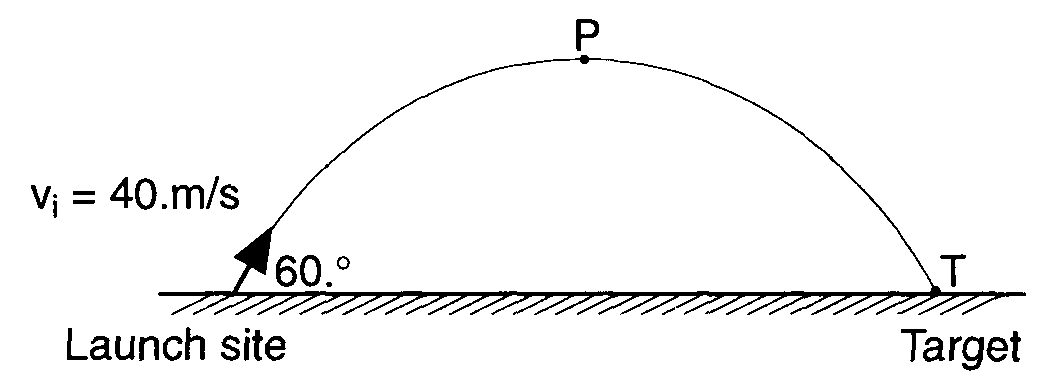1. How far will a freely falling object, initially at rest, fall in
2.4 s ?
6.0 m
12 m 23 m
28
m
2. An object originally at rest is uniformly accelerated along a
straight-line path to a speed of 8.0 m/s in 2.00 s. The
acceleration of the object is
0.25 m/s2
10 m/s2 16 m/s2
4.0
m/s2
3. To change the velocity of an object, there must be
an increase in its
speed a decrease in its speed
a
change in either its speed or direction
![]() Questions 4 through 6 : A ball is kicked at an angle of 30o from the horizontal. The ball has an initial velocity of 5.0 m/s.
Questions 4 through 6 : A ball is kicked at an angle of 30o from the horizontal. The ball has an initial velocity of 5.0 m/s.
![]() [Neglect friction.]
[Neglect friction.]
4.![]() What is the magnitude of the horizontal component of the ball's initial velocity ?
What is the magnitude of the horizontal component of the ball's initial velocity ?
![]() 2.5 m/s
2.5 m/s
![]() 4.3 m/s
4.3 m/s
![]() 5.0 m/s
5.0 m/s
![]() 8.7 m/s
8.7 m/s
5.![]() As the ball rises, the vertical component of its velocity
As the ball rises, the vertical component of its velocity
![]() decreases
decreases
![]() increases
increases
![]() remains the same
remains the same
6.![]() If the angle between the horizontal and the direction of the 5.0 m/s velocity decreases from 30o to 20o,
If the angle between the horizontal and the direction of the 5.0 m/s velocity decreases from 30o to 20o,
![]() the horizontal distance the ball travels will
the horizontal distance the ball travels will
![]() decrease
decrease
![]() increase
increase
![]() remain the same
remain the same
![]() Base your answers to questions 7 through 11 on the diagram below which shows the
trajectory of a projectile launched
Base your answers to questions 7 through 11 on the diagram below which shows the
trajectory of a projectile launched
![]() on the Earth's surface.
on the Earth's surface.

7.![]() What is the
initial vertical velocity of the projectile ?
What is the
initial vertical velocity of the projectile ?
![]() 35 m/s
35 m/s![]() 20 m/s
20 m/s![]() 40 m/s
40 m/s![]() 30 m/s
30 m/s
8.![]() What is the
initial horizontal velocity of the projectile ?
What is the
initial horizontal velocity of the projectile ?
![]() 35 m/s
35 m/s![]() 20 m/s
20 m/s![]() 40 m/s
40 m/s![]() 30 m/s
30 m/s
9.![]() If the angle
were decreased to 50o, the horizontal distance traveled by the projectile would
If the angle
were decreased to 50o, the horizontal distance traveled by the projectile would
![]() decrease
decrease![]() increase
increase![]() remain the same
remain the same
10.![]() What is the horizontal
velocity of the projectile at point P ?
What is the horizontal
velocity of the projectile at point P ?
![]() 35 m/s
35 m/s![]() 20 m/s
20 m/s![]() 40 m/s
40 m/s![]() 30 m/s
30 m/s
11.![]() What is the vertical
velocity of the projectile at point P ?
What is the vertical
velocity of the projectile at point P ?
![]() 35 m/s
35 m/s![]() 20 m/s
20 m/s![]() 40 m/s
40 m/s![]() 0 m/s
0 m/s
12. An object is accelerated uniformly from rest to a speed of 25 m/s
in 10.0 s. The acceleration of the object is
1.0 m/s2
2.0
m/s2 1.5 m/s2 2.5 m/s2
13. Starting from rest, how far can a 2.00 kg mass fall freely in 1.00
s ?
4.90 m
2.00 m 9.80 m 19.6 m
14. As the time required to accelerate an object from rest to a speed
of 4 m/s decreases, the acceleration of the object
decreases
increases
remains
the same
15. As an object falls freely near the earth, its acceleration
decreases
increases
remains
the same
16. Which of the following is a vector quantity ?
distance
speed
acceleration
mass
17. A woman jogs 300 m north, then 400 m east. What is the
displacement of the woman ?
500 m
500
m northeast 700 m
700 m northeast

23. ![]() What is the
distance traveled by the object during the time interval 8 to 11 seconds ?
What is the
distance traveled by the object during the time interval 8 to 11 seconds ?
![]() 30 m
30 m![]() 60
m
60
m![]() 90 m
90 m![]() 180 m
180 m![]()
24. What is the average speed of a car that travels 1200 m in 20. s ?
20 m/s
60
m/s 120
m/s 0.017 m/s
25. A cart initially traveling at 10. m/s north accelerates uniformly
at 3.0 m/s2 to the north for 4.0 s. The displacement
of the cart during the 4.0 s from its initial position is
40. m north
64
m north 88 m
north 180 m north
26. An object initially traveling at 20. m/s south decelerates
uniformly at 6.0 m/s2 and is displaced 25 m. What is the
final velocity of the object ?
26 m/s north
26 m/s
south 10 m/s north 10 m/s south
27. Which is constant for a freely falling object ?
acceleration
velocity speed displacement
28. In an experiment that measures how fast a student reacts, a meter
stick dropped from rest falls 0.20 m before the
student catches it. The reaction time of the student is approximately
0.10 s
0.20
s 0.30 s
0.40 s
29. The width of your little finger is closest to
1 m
0.1 m
0.01 m
0.001 m
30. Which of the following statements is true ?
The velocity of a projectile at its maximum height is zero.
The acceleration of a projectile at its maximum height is zero.
The horizontal velocity of a projectile at its maximum height is zero.
The vertical velocity of a projectile at its maximum height is zero.